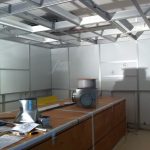 Chemicals, water, and energy consumption are cornerstones of nearly all cleanroom processes. They are also the three areas that most affect the “greenness” of these operations. Reducing the use of any of these would certainly result in cost savings for companies. The question is: how plausible is to alter these things and still leave the process effective and efficient?
Chemicals, water, and energy consumption are cornerstones of nearly all cleanroom processes. They are also the three areas that most affect the “greenness” of these operations. Reducing the use of any of these would certainly result in cost savings for companies. The question is: how plausible is to alter these things and still leave the process effective and efficient?
In manufacturing, we question how holistic regulations will affect production schedules, product quality, risks to employees, and damage to the environment. Implementing green practices are sure to change chemicals and/or processes that affect these four areas. As much as businesses support green processes, accepting changes depend greatly on their impacts to the operation as a whole.
Controlled Environments writers Barbara Kanegsberg and Ed Kanegsberg interviewed experts about the challenges and possibilities of a green, safe and sustainable future in “2020 Vision: Green, Safe, Sustainable – Part 1.”
Expert speculation on the future of going green is summarized as follows:
- Chemicals: Predictions here revolved around A) “disappearing chemistries,” like boron and nonophenols, and B) cleaning products designed with greener characteristics, like longer bath life.
- Conserving water: Water consumption may be reduced by “purifying and recycling the water or reusing it in less critical processes.”
- Conserving energy: Similar to recycling or reusing water, energy can be used again. Taoward Lee, Manager of Technology at Ecosystems Inc. in Costa Mesa, CA said, “For example, process baths can be heated while making distilled water.” He adds, “One way to reduce chemical consumption is to reduce dragout, capture the remaining dragout, and return it to the process immediately. This uses less chemical and keeps the rinses cleaner.”
- Bio-based solutions: Experts also predict that bio-based agents, using natural chemicals that can be grown, are in our future. Ideally, if cleaning products can be made from waste feedstock or waste fuel, food production is unaffected by the process of creating new cleaning agents, and nothing goes into a landfill.
Tackling these issues require multiple changes. Lee explained that reducing the heat required for pretreatment to painting or coating will lower energy consumption. However, the heat is required to tackle oils and soils, so as a result, the melting temperature of the oils would have to be lowered. John Burke, CMFS STLE Fellow and Global Director of Engineering Services at Houghton International in Valley Forge, PA, says that this kind of reformulation is being achieved through congruent chemistries. This appears to be a promising area of change. He says:
“In fact, 99% of people you ask probably won’t know what congruent chemistry means, and an engineer might say ‘I don’t care;’ but if you can reduce waste streams from 50,000 gallons per day to 1,500 gallons per day, you have an impact that is difficult to ignore.”
Overall, the wheels are turning to create greener methods for cleanroom processes. The green revolution will depend on the efforts of many, and promise to benefit the entire industry. For questions about cleanrooms, contact Gerbig Engineering Company at 888-628-0056 or info@gerbig.com.